Inspired by Julie & Julia, I've embarked on a project to celebrate the Cuban kitchen - the food, the abuelas who prepared it, and the family that gathered around the table to enjoy every bite. I'm cooking my way through Nitza Villapol's Cocina al Minuto. With each recipe, I hope to inspire you to bring the joy (and sofrito smell) back into your home.
Monday, August 24, 2009
22: Ropa Vieja
2 lb falda (skirt steak), cooked (to make beef broth)
1/3 cup oil
1 onion, thinly sliced
2 garlic cloves, minced
1 green pepper, chopped
1 can tomato sauce
1 teaspoon salt
1 bay leaf
1/2 cup dry white wine
1 can pimentos (can be chopped
1. Shred the beef, using two forks.
2. Heat the oil and add the onion, garlic and green pepper, until softened.
3. Add the meat and rest of the ingredients to the pot.
4. Cover and cook over low heat for 20 minutes.
5. Stir occasionally, to avoid sticking.
Serve over hot white rice. Makes 8 servings.
21: Sopa de Cebollas / French Onion Soup
2 cups white onions, sliced in rings
1/8 lb butter
1 1/2 cups beef broth
1 cup water
1/2 teaspoon Worcestershire sauce
4 slices bread, toasted
1/4 cup parmesan cheese, grated
1. Melt the butter and add the onion rings.
2. Cook the onion in the butter until softened.
3. Mix the broth, water and worcestershire in a bowl and add to the onions.
4. Cover, and cook over low heat for 25 minutes.
5. Place the toasted bread in bowls and top with the soup.
6. Add the grated cheese over the top.
7. Place the bowls in the oven, under the broiler, for a few minutes, until cheese is golden.
Makes 4 servings.
Bueno, Bonito y Beef Broth
Last Sunday, I took a trip to Publix with my family and my list. As I went back to my soups chapter, which I had deserted for a while, I found that the next recipe up was sopa de cebollas. I love French Onion Soup so I was excited to make it at home. Because I needed consommé for the sopa de cebollas, I decided I wanted to make beef broth so I picked ropa vieja to make as well, where by in the process, you end up with both beef broth and meat for the ropa vieja. It didn’t occur to me until now that consommé may not actually be caldo de res. But, since Nitza doesn’t have a recipe for consommé in the book, I think my decision to go with caldo de res was just fine.
Finally, I looked through the chapters and found one for Sandwiches y Bocaditos and thought – sandwiches? There’s a chapter on sandwiches? The first one was for Bocaditos de Bonito. I didn’t even know that bonito was a high grade tuna until a friend told me, so I decided to give it a try.
Recipe #594: Bocaditos de Bonito
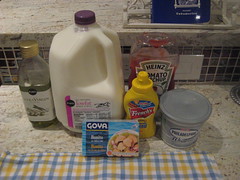
Pastica de jamón is my all-time favorite Cuban sandwich spread. My father in law buys one from Sedano’s that is really amazing. When it’s my turn to pick up the kids, I have to avoid the fridge because that pastica screams loudly from inside.
The recipe for Bocaditos de Bonito really calls for you to make the spread and put it on pan de molde (white bread) but I decided to just do the pastica version so I could try it out.
The ingredients were simple : 1 can bonito in oil, ½ cup ketchup, 2 teaspoons mustard, 2 Tablespoons milk, 1 teaspoon olive oil and 12 oz cream cheese (I went with the Whipped version, no reason). Basically, you take all those ingredients, except for the cream cheese, and you put them in the food processor until all ingredients are mixed well together. You take the mix from the food processor and you add it to another bowl where you have the cream cheese at room temp. Mix that in well and serve with Cuban crackers.
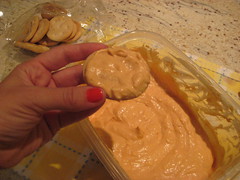
My friends were commenting as I posted the process on Facebook on Sunday night and let’s just say they didn’t find the recipe or photos of the end result very appetizing. All I can tell you is that the pastica de jamón that calls for me at the suegros’ house ain’t got nothin’ on this pastica de bonito.
Late Sunday night, I decided to prep ahead (see, I’m learning!) for Monday’s throwdown (with myself). I took the falda I would need and put it in the olla de presión to end up with both caldo de res (a.k.a. consommé in my book) and beef to shred for the ropa vieja.
I made the beef broth by adding the usual 3 green peppers, 3 tomatoes, 3 cloves garlic, 1 onion, parsley and 1 Tablespoon of salt, along with 6 cups of water to the 2 pounds of falda (beef, maybe skirt steak? You ask for falda in Miami and the butcher knows what you need) and a soup bone I had frozen from a long, long time ago (last month when I started The Project).
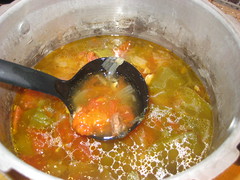
Once the chaca chaca started from the pressure cooker, it was time to lower the heat to medium for the next 30 minutes. That’s when I actually started to make the pastica de bonito, so I can tell you that it takes less than 30 minutes, from start to finish, on the pastica.
Nice, right? Less than 30 minutes for pastica. Rachael Ray can feed an army of 300 in less than 30 minutes and esta que está aquí (this lady right here) can feed you pastica while you wait a few hours for your home cooked Cuban meal!When the 30 minutes were up, it was time to get busy on the meat. I had picked out the cooked meat with tongs and put it aside and strained the broth and put the caldo de res in mini containers for my sopa de cebollas.
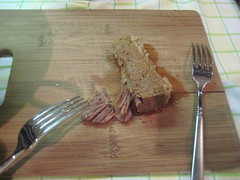
I know that you shred beef with two forks from seeing it on TV, but I had never really done that myself. So, I took out my forks and…
I had to get my camera. It was ropa vieja looking meat! Really, that easy?
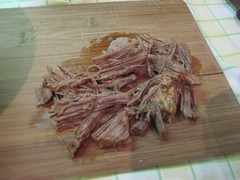
You see, ropa vieja is another one of those mystery foods to me. I’ve never watched anyone make it in front of me, it’s just something you had on your plate with rice. When I saw that my meat was looking like that ropa vieja that is one of the famous must-haves in Cuban food, I had to capture the moment.
Once I had finished shredding the beef and singing some sort of "shredding the beef" song, I packed it up and put it aside to cool. Ready for the fridge for Monday night, along with the beef broth for the sopa de cebollas. Dinner on Monday was going to be a snap.
Or, at least a few snaps.
On Sunday, when I was planning my mega-weeknight meal (naïve), I had forgotten that I rarely ever leave work before 6:00 p.m. and that in order to make sopa de cebollas, ropa vieja and KILLER RICE (yeah!), I was going to have to focus and leave on time.
So, I did. At 6:00 p.m.
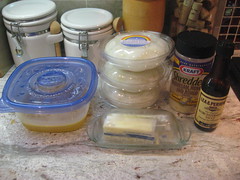
When I got home, I pulled out the French Onion Soup ingredients – 2 cups of finely sliced onions (that I had bought pre-sliced at Publix – I splurged to save time), 1/8 pound (4 Tablespoons) of butter, 1 ½ cups of consommé caldo de res, 1 cup water, ½ teaspoon salsa inglesa, 4 slices of bread…
Bread? Oh no.
I had forgotten to buy pan de molde!
A quick search around the kitchen resulted in a quick fix – hot dog buns.
Seriously! I opened them up, put them in the toaster and sliced them in half and had 2 servings, one for each of us.
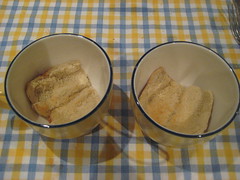
The recipe was so easy, I had my daughter help me prepare it. I got the half brick o’butter and melted it into a deep pot and my daughter opened up the sliced onion packets for me and I threw them all in there until the onions got nice and shiny and soft. My daughter had mixed in the water and salsa inglesa into the caldo de res and I threw that all into the pot, on low heat, for about 30 minutes. Bye bye – on to the next dishes…
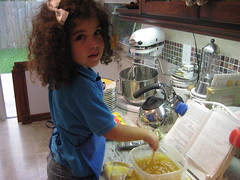
For the ropa vieja I should have chopped up the vegetables the night before, but will remember to do that the next time.
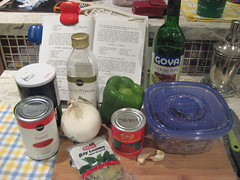
I chopped 1 onion, 2 garlic cloves and 1 green pepper and put that sofrito mix in another deep pot with 1/3 cup olive oil. I took advantage and got the 2 garlic cloves I needed for Killer Rice (white rice) and put them into the olive oil to get the rice going as well in yet another pot. I actually had all four burners going for the first time in my life.
When the sofrito was perfect smelling and steaming, I added the shredded beef I had prepped the night before. When you’ve got the sofrito and the meat all nice and cohabitated, you add a can of tomato sauce, 1 teaspoon of salt, 1 hoja de laurel (bay leaf), ½ cup vino seco and 1 can of pimientos morrones (pimentos) that you have taken out from their liquid and chopped up.
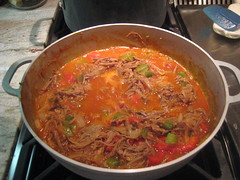
That’s it, baby! Low heat for 15 to 20 minutes (or until you’ve got your act together, really) and you’re ready to rumble.
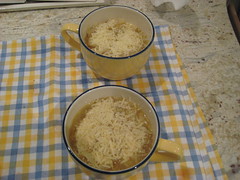
We had sopa de cebollas for appetizer. I added some grated parmesan on the top that melted so nicely with the heat from the soup and we had ropa vieja con arroz blanco for our main dish.
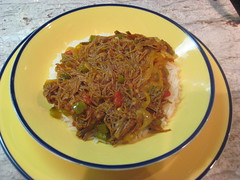
Dinner on Monday was amazing. My kids thought I was nuts with all the running around and all the pots and burners going at the same time.
My daughter tried the ropa vieja and she liked it. She didn’t eat a whole plate of it, yet, but at least she liked it. That’s a big first for her. She helps with everything but doesn’t like much of anything. Ever since she turned four, she’s been extremely picky about her menu! But, I keep her in the kitchen with me and I tell her she’s my taste tester. And, that if it weren’t for her taste testing my food, I wouldn’t know how to make it taste good.
Somehow, that logic is working, and she’s loving The Project. Now, if I could only get her to try the pastica de bonito!
Sunday, August 23, 2009
20: Bocaditos de Bonito
1 can Bonito in olive oil
1/2 cup ketchup
2 teaspoons mustard
2 Tablespoons milk
1 teaspoon oil
12 oz cream cheese
Loaf of white bread or Cuban Crackers
1. In a food processor, blend the bonito, ketchup, mustard, milk and oil.
2. Beat the cream cheese until softened and add the blended ingredients from the food processor.
3. Mix well and spread over white bread to make tea sandwiches, or serve on top of cuban crackers.
Monday, August 3, 2009
10: Fritas
¾ pound ground chuck (80/20)
¼ pound ground pork
¼ cup milk
½ cup white bread, cubed, crusts removed (about two slices)
1 Tablespoon onion, minced
1 egg
1 Tablespoon ketchup
2 teaspoons salt
½ teaspoon paprika
½ teaspoon Worcestershire sauce
¼ teaspoon black pepper
1. Measure out the milk in a measuring cup and add the bread cubes. Mix the bread in well so it can fully soak up the milk.
2. Mix the meats together and add in the soaked bread cubes, the beaten egg, ketchup, salt, paprika, Worcestershire sauce and black pepper.
3. Mix everything well, preferably with your clean hands, and form them into small meatball sizes.
4. Leave in the refrigerator for at least two hours before cooking. Overnight is best.
5. In a hot skillet, fry up the fritas, without added grease.
6. Flatten them out only once on the pan. You only want to render enough fat from the fritas to let them fry up properly but not to release the juices from the meat.
7. Cook on both sides and set aside as you cook them.
8. Open your potato rolls and place them, insides down, on the skillet to toast up and soak up some of the frita juices.
9. Place a frita patty inside each potato roll and top with ketchup, hot sauce and mini shoestring fries.
Makes about 16 fritas.
Note: for the Tailgating version, I added ¼ pound of ground chorizo to the meat mix. Good for spicier results.